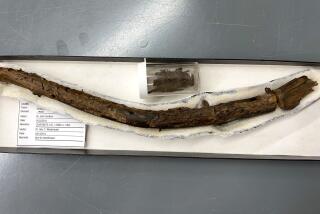Uncommon Plants Found From Marshes to Mesas
- Share via
Three plants that grow in San Diego County--the endemic San Diego mesa mint, salt marsh bird’s beak and slender-horned spine flower--appear on the federal endangered species list. Regulators now are considering three additions--San Diego coyote thistle, California Orcutt grass and Otay Mesa mint.
According to the state Department of Fish and Game, 26 native plants on the state endangered species list grow in the county. Their descriptions are based on R. Mitchel Beauchamp’s “A Flora of San Diego County, California.”
San Diego thorn-mint: This uncommon flower grows in clay soils on mesas and in valleys in coastal areas. It has been spotted in Encinitas, San Marcos, San Bernardo and La Costa.
* Coastal dunes milk-vetch: Also known as coastal dune locoweed, it is found in alkaline areas such as the Santa Margarita river estuary and the Silver Strand.
* Encinitas coyote brush: Endemic to San Diego County, it grows in chaparral, and has been seen near Mira Mesa, Poway, Del Dios and Encinitas.
* Threadleaf brodiaea: It grows in grasslands and vernal pools, including at Alta Loma Creek, San Marcos Hills and Thibodo Ranch.
* Dunn’s mariposa-lily: It is found near Julian, grows on mountain slopes and foothills.
* Slenderpod squaw-cabbage: It grows on slopes in areas such as Harbison Canyon and Tecate Mountain.
* Orcutt’s spineflower: It grows on coastal mesas, including at Point Loma, Del Mar and Encinitas.
* Salt marsh bird’s beak: It grows in coastal salt marshes in Chula Vista, Imperial Beach and the Tijuana River Estuary.
* Cuyamaca larkspur: It is found near Lake Cuyamaca, usually on grassy slopes.
* Cuyamaca Lake downingia: These plants with purple petals are found on the eastern edge of Cuyamaca Lake.
* Short-leaved live-forever: This endemic plant with small, white flowers can be found on bare, sandstone terraces in Del Mar, North City West and Torrey Pines State Reserve.
* San Diego coyote-thistle: It is found at vernal pools at Miramar Naval Air Station.
* Mexican flannelbush: It grows in shaded canyons, including some near Jamul.
* Borrego bedstraw: It lives on brushy slopes near San Onofre, Mt. Soledad, Torrey Pines and other areas.
* Otay tarplant: It grows on clay slopes and mesas.
* Parish’s slender meadowfoam: It grows near Lake Cuyamaca, on Mt. Laguna and Palomar Mountain.
* Laguna Mountain aster: Beauchamp found this plant “2 miles south of the main recreation area in the Laguna mountains . . . at 5,200 feet elevation . . . on dry slope under pines.”
* Nevin’s barberry: It has been seen in Torrey Pines State Reserve, Agua Tibia Wilderness area and Spring Valley.
* Willowy monardella: This uncommon plant grows in Murphy Canyon, Mira Mesa, Poway and San Diego.
* Dehesa beargrass: This plant grows in the desert.
* California Orcutt grass: Another vernal pool resident, Orcutt grass grows near a runway at Miramar Naval Air Station and in Otay Mesa.
* San Diego mesa mint: It is found in a few remaining vernal pools.
* Otay Mesa mint: This close relative of the San Diego mesa mint grows on mesas in the Otay Mesa area.
* Gander’s butterweed: Another endemic plant, the Gander’s butterweed grows in foothills near Tecate Mountain and Lawson Peak.
* Slender-horned spine flower: Although the plant was known to grow in San Bernardino, Orange and Los Angeles counties, naturalists learned only within the past few months that it was growing on federal forest lands in San Diego.
* Small-leaved rose: The most recent plant to join the California endangered list grows only on western Otay Mesa.
More to Read
Sign up for The Wild
We’ll help you find the best places to hike, bike and run, as well as the perfect silent spots for meditation and yoga.
You may occasionally receive promotional content from the Los Angeles Times.






